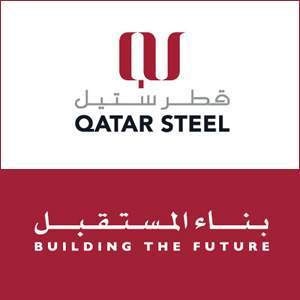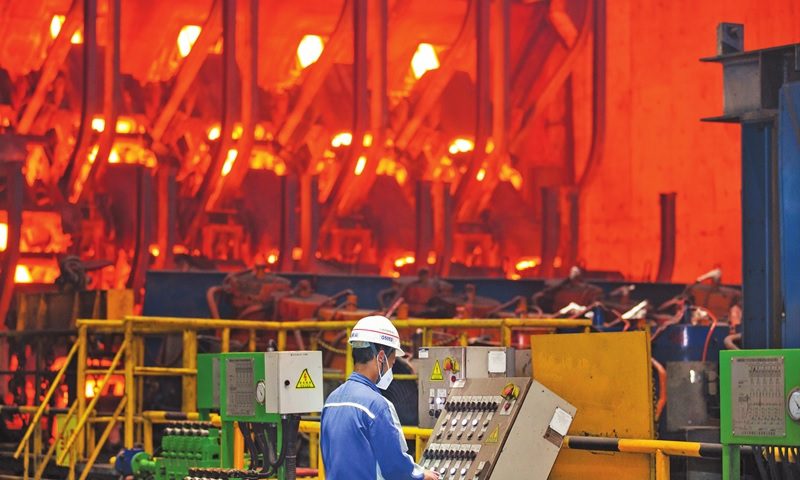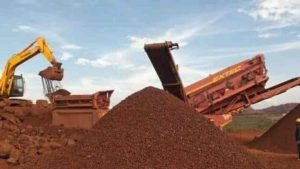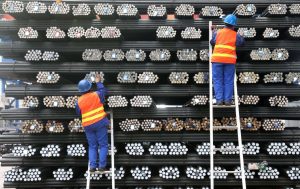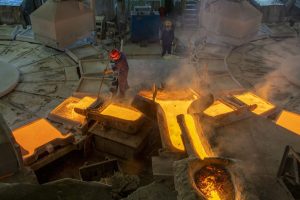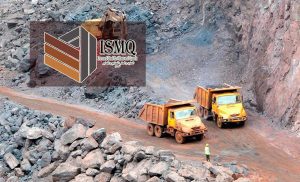China’s steel industry has increased its reliance on coal-fired projects significantly over the past 5 years, despite concerns about falling profits, oversupply and commitments to cut carbon emissions.
China currently produces more than 1 billion tons of steel, accounting for more than half of the world’s production of the metal used mainly in the construction and building industries, according to recent data from the Center for Research on Energy and Clean Air.
The steel industry in China relies on the method of coal-based blast furnaces (blast furnaces – basic oxygen furnaces), which causes an intensity of emissions from the industry and poses great challenges to Beijing’s commitments to reduce emissions and reach carbon neutrality by 2060, 10 years behind Europe and America.
The bulk of China’s steelmaking emissions are often generated during coal-fired processes to deoxygenate iron ore, a carbon-intensive process, according to the Energy Research Unit (ERU) that monitors it regularly.
The transformation of the steel industry in China to low- or zero-emission production methods is necessary to achieve carbon neutrality goals, not only in Beijing, but globally, as hopes relate to the efforts of China and India to lead the global transition towards renewable energy, along with the efforts of America and Europe.
Decarbonization of the industry requires huge investments in zero-emission technologies, in addition to the need to bring carbon-intensive factories to early closure, but that goal seems distant in light of continued investments in coal-based production methods.
China’s steel industry also faces challenges of continuous capacity expansion and anemic profit rates, with government control over production increasing in recent years, complicating the industry’s shift to less polluting methods.
Government control of the industry
Recent data showed that China’s crude steel production has decreased significantly since 2021, due to government control of production and declining demand, according to a report by the Clean Air and Energy Research Center.
Despite the decline in production, new investments in the iron and steel industry have not yet adapted to the new reality, and are still continuing to flood the sector with more additional capacity.
Observers fear that the surplus capacity in the Chinese steel industry will turn from a short-term situation that market interactions can overcome, to a chronic, long-term structural glut whose consequences are difficult to escape.
It is expected that the problem of excess capacity will affect the profits of iron and steel companies, which cannot continue to operate at less than the level of 80% of production capacity, otherwise they will suffer operational losses and a significant decline in revenues and profits.
Map of new projects in 5 years
Chinese steelmakers increased their investment in new coal-based projects significantly from 2017 to the first half of 2023.
And the Chinese provincial governments granted approvals to launch new projects in the iron industry with a capacity of 384.3 million tons annually during the period from 2017 to June 2023.
The provinces also approved similar projects in the steel industry with a capacity of 425.9 million tons per year, during the same period, according to data monitored by the Energy Research Unit.
These numbers mean that the rate of approval of new projects in the steel industry has reached 30 million tons annually every 6 months, equal to the total steel production capacity in Germany.
Most of the new approvals are part of China’s existing capacity replacement policy for the steel industry, which requires shutting down as much old capacity as possible while pumping new capacity into the industry to keep pace with the country’s larger economic developments.
Private iron and steel companies lead the majority of new projects with 69%, followed by regional state-owned companies and central government-owned companies with 26% and 5% respectively.
Most projects are carbon intensive
Most of the new projects in China’s steel industry rely on blast furnaces and basic oxygen furnaces, both of which generate heavy carbon emissions, unlike electric arc furnaces, which are bet on reducing steel industry emissions in Asia and the world.
The global furnaces represent 99% of the capacity of the new steel projects that obtained approvals during the past 5 and a half years until June 2023, while the basic oxygen furnaces represent 70% of the capacity of the new steel industry during the same period.
This data indicates that China’s steel industry has renewed at least a quarter of its production capacity through new projects using the same carbon-intensive production methods for the next 40 years, according to the report of the Clean Air and Energy Research Center.
China introduced electric arc furnaces to the industry during the past years, but their prevalence rate is still lower, compared to other countries accelerating in this field such as the United States, Iran and Turkey.
China’s operational capacity in the steel industry amounted to approximately 1.1 billion metric tons until 2022, but most of it is still dependent on basic oxygen furnaces (819 million tons), while the capacity dependent on electric arc furnaces does not exceed 114.8 million tons, according to Global platform data. Specialized Energy Monitor (global energy monitor).
Do projects turn into stranded assets?
Despite China’s pledge to achieve the declared carbon removal goals in 2020, it has approved new projects in the iron and steel industry with a capacity of 119.8 million tons annually based on blast furnaces, and 76.6 million tons based on basic oxygen furnaces during the period from 2021 to the first half of 2023.
The steel industry in China risks investing in new projects that rely on carbon-intensive technologies in the long term, which may expose these investments to stranded assets in the coming decades.
The Clean Air and Energy Research Center estimates the amount of assets at risk to be outstanding from approved projects announced after 2020, at $100 billion (700 billion yuan).
Although China is accelerating the adoption of new steel projects based on carbon-intensive furnace technologies, EAF projects are also witnessing a rapid increase in approvals.
Share electric arc furnaces?
Chinese authorities and provincial governors have approved new EAF-certified projects with a capacity of 52.5 million tons per year from 2021 to the first half of 2023.
The share of electric arc furnaces increased to 30%-40% of new steel projects announced in 2021, but their share of the total capacity of China’s steel industry is still much lower.
New steelmaking projects with a capacity of 4.7 million tons per year have also been approved with a commitment to zero-emission technologies, amid China’s approved capacity replacement policy, according to the Energy Research Unit.
It is expected that the new projects approved during the past years will be operational by 2025, which means that China will renew 40% of its production capacity in the iron and steel industry.
The Clean Air and Energy Research Center proposes some recommendations to ensure the success of the substitution policy adopted in the Chinese steel industry in achieving its goals in parallel with the long-term objectives of reducing emissions and carbon neutrality.
The first recommendation is that the old shutdown capacity should be greater than or equal to the new incremental capacity, ensuring net industry-wide reduction of emission-intensive capacity.
The think tank also proposes the inclusion of the steel industry in China’s emissions trading system during the 14th Five-Year Plan in China, as well as the need for new investments in blast furnaces and accelerating the deployment of electric arc furnaces in the industry, as well as promoting the transformation towards hydrogen-based steelmaking technologies.
Taken together, these proposals could contribute to China’s steel industry emissions peaking before 2025, in preparation for a gradual decline thereafter.
source / attaqa





